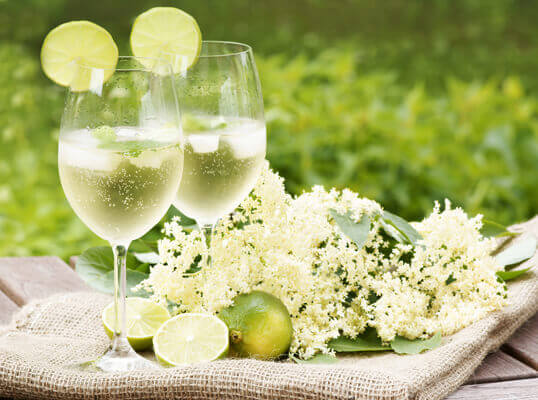Hugo
Hugo is one of the most popular and easy-to-prepare aperitifs for summer. The drink has an incredibly refreshing taste and can even convince cocktail fans. It can be ordered and enjoyed in cocktail bars and restaurants, or simply prepared at home. Hugo is the reaction to the Aperol Spritz aperitif. We would like to show you the simple Hugo recipe and hope you have fun preparing and enjoying it!
Hugo recipe
- 20 cl Prosecco
- 12 cl soda water
- 2.5 cl elderflower syrup
- One lime
- Mint leaves
Step by Step Guide
- Slice the lime and place two slices in a wine glass along with some mint leaves.
- Add all the other ingredients and stir gently with a bar spoon.
- Grain (with mint leaves) and serve or enjoy by yourself!
The Hugo cocktail is very simple to prepare. To make it, first slice the lime and put two or three slices in a wine glass together with some mint leaves. Then add the prosecco, soda water and elderflower syrup to the glass. Now stir all the ingredients lightly and briefly with a bar spoon. You can then garnish the drink with a few mint leaves. Then serve the aperitif to your friends, guests family members or simply enjoy the drink yourself.
Bar accessories:
- Bar spoon
- Wine glass
- Jigger
The taste profile of the Hugo Cocktail
46 Reviews
The cocktail tastes refreshing and very mild. The pleasantly sweet and fruity taste of the elderflower syrup even underlines this taste experience. The slightly sour notes of the lime juice harmonise very well with the taste of the mint. The drink is unique in taste and very refreshing. It is most comparable to other aperitifs such as Aperol Spritz, Bellini, Mimosa or French 75.
The answer to the Aperol Spritz
The Hugo is a cocktail that is slightly similar in ingredients to the Caipirinha and Mojito. Just like these two mixed drinks, the Hugo is preferably served in summer and convinces with a refreshing taste. However, many people do not know that this aperitif is the direct answer to the Aperol Spritz. After the Aperol Spritz spread to Europe in the early 2000s, some bartenders started looking for alternative drinks. Bartender Roland Gruber found what he was looking for in 2005. He prepared the first Hugo cocktail in South Tyrol’s Vinschgau region. He chose the name “Hugo” more or less by chance.
The aperitif became more and more popular, so that it slowly spread throughout South Tyrol. It took at least five years for the drink to establish itself in Germany. But today the Hugo is part of the basic equipment of every bar and restaurant. The drink is incredibly popular and is even declared the most popular cocktail of all. However, it is questionable whether it can prevail against the strong competition of Caipirinha, Mai Tai, Mojito, Cuba Libre, Gin Basil Smash and Dry Martini.
More Drink Recipes
More Drink Recipes
FAQ
What is Hugo?
Hugo is one of the most popular aperitifs in Germany. It is the direct competitor of the Aperol Spritz and can be ordered in just about every bar and restaurant.
How do you prepare the drink?
Simply add lime slices, mint leaves, soda water, Prosecco and elderflower syrup to a wine glass. Then stir the ingredients gently and add a few mint leaves to the glass. Now you can serve the drink or enjoy it yourself.
How does the cocktail taste?
Several different ingredients come together in the preparation of this aperitif. As a result, the drink tastes pleasantly sweet and mild. The slightly sour notes of the lime harmonise very well with the taste of the mint. The drink is very refreshing and incredibly aromatic.
Do you prepare the Hugo with sparkling wine, prosecco or champagne?
We prefer to prepare the recipe with prosecco. The pleasantly sparkling and mild taste goes particularly well with the elderflower syrup. However, you can also use sparkling wine or even champagne for the preparation. In terms of taste, these sparkling wines do not differ that much from each other.




